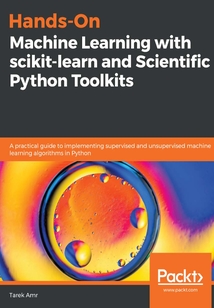首頁 > 計算機網絡 >
編程語言與程序設計
> Hands-On Machine Learning with scikit:learn and Scientific Python Toolkits最新章節目錄
舉報 

會員
Hands-On Machine Learning with scikit:learn and Scientific Python Toolkits
Machinelearningisappliedeverywhere,frombusinesstoresearchandacademia,whilescikit-learnisaversatilelibrarythatispopularamongmachinelearningpractitioners.Thisbookservesasapracticalguideforanyonelookingtoprovidehands-onmachinelearningsolutionswithscikit-learnandPythontoolkits.Thebookbeginswithanexplanationofmachinelearningconceptsandfundamentals,andstrikesabalancebetweentheoreticalconceptsandtheirapplications.Eachchaptercoversadifferentsetofalgorithms,andshowsyouhowtousethemtosolvereal-lifeproblems.You’llalsolearnaboutvariouskeysupervisedandunsupervisedmachinelearningalgorithmsusingpracticalexamples.Whetheritisaninstance-basedlearningalgorithm,Bayesianestimation,adeepneuralnetwork,atree-basedensemble,orarecommendationsystem,you’llgainathoroughunderstandingofitstheoryandlearnwhentoapplyit.Asyouadvance,you’lllearnhowtodealwithunlabeleddataandwhentousedifferentclusteringandanomalydetectionalgorithms.Bytheendofthismachinelearningbook,you’llhavelearnedhowtotakeadata-drivenapproachtoprovideend-to-endmachinelearningsolutions.You’llalsohavediscoveredhowtoformulatetheproblemathand,preparerequireddata,andevaluateanddeploymodelsinproduction.
目錄(112章)
倒序
- 封面
- 版權信息
- About Packt
- Why subscribe?
- Contributors
- Preface
- Who this book is for
- What this book covers
- To get the most out of this book
- Get in touch
- Section 1: Supervised Learning
- Introduction to Machine Learning
- Understanding machine learning
- The model development life cycle
- Introduction to scikit-learn
- Installing the packages you need
- Summary
- Further reading
- Making Decisions with Trees
- Understanding decision trees
- How do decision trees learn?
- Getting a more reliable score
- Tuning the hyperparameters for higher accuracy
- Visualizing the tree's decision boundaries
- Building decision tree regressors
- Summary
- Making Decisions with Linear Equations
- Understanding linear models
- Predicting house prices in Boston
- Regularizing the regressor
- Finding regression intervals
- Getting to know additional linear regressors
- Using logistic regression for classification
- Getting to know additional linear classifiers
- Summary
- Preparing Your Data
- Imputing missing values
- Encoding non-numerical columns
- Homogenizing the columns' scale
- Selecting the most useful features
- Summary
- Image Processing with Nearest Neighbors
- Nearest neighbors
- Loading and displaying images
- Image classification
- Using custom distances
- Using nearest neighbors for regression
- More neighborhood algorithms
- Reducing the dimensions of our image data
- Summary
- Classifying Text Using Naive Bayes
- Splitting sentences into tokens
- Vectorizing text into matrices
- Understanding Naive Bayes
- Classifying text using a Naive Bayes classifier
- Creating a custom transformer
- Summary
- Section 2: Advanced Supervised Learning
- Neural Networks – Here Comes Deep Learning
- Getting to know MLP
- Classifying items of clothing
- Untangling the convolutions
- MLP regressors
- Summary
- Ensembles – When One Model Is Not Enough
- Answering the question why ensembles?
- Downloading the UCI Automobile dataset
- Using random forest for regression
- Using random forest for classification
- Using bagging regressors
- Using gradient boosting to predict automobile prices
- Using AdaBoost ensembles
- Exploring more ensembles
- Summary
- The Y is as Important as the X
- Scaling your regression targets
- Estimating multiple regression targets
- Dealing with compound classification targets
- Calibrating a classifier's probabilities
- Calculating the precision at k
- Summary
- Imbalanced Learning – Not Even 1% Win the Lottery
- Getting the click prediction dataset
- Installing the imbalanced-learn library
- Predicting the CTR
- Sampling the training data
- Equal opportunity score
- Summary
- Section 3: Unsupervised Learning and More
- Clustering – Making Sense of Unlabeled Data
- Understanding clustering
- K-means clustering
- Agglomerative clustering
- DBSCAN
- Summary
- Anomaly Detection – Finding Outliers in Data
- Unlabeled anomaly detection
- Detecting anomalies using basic statistics
- Detecting outliers using EllipticEnvelope
- Outlier and novelty detection using LOF
- Detecting outliers using isolation forest
- Summary
- Recommender System – Getting to Know Their Taste
- The different recommendation paradigms
- Downloading surprise and the dataset
- Using KNN-inspired algorithms
- Using baseline algorithms
- Using singular value decomposition
- Deploying machine learning models in production
- Summary
- Other Books You May Enjoy
- Leave a review - let other readers know what you think 更新時間:2021-06-18 18:24:48
推薦閱讀
- C語言程序設計案例教程
- JBoss Weld CDI for Java Platform
- Vue.js 2 and Bootstrap 4 Web Development
- JIRA 7 Administration Cookbook(Second Edition)
- iOS開發實戰:從零基礎到App Store上架
- 從程序員到架構師:大數據量、緩存、高并發、微服務、多團隊協同等核心場景實戰
- Web Application Development with R Using Shiny(Second Edition)
- VMware vSphere 6.7虛擬化架構實戰指南
- Android開發案例教程與項目實戰(在線實驗+在線自測)
- 劍指Java:核心原理與應用實踐
- Learning Vaadin 7(Second Edition)
- C語言程序設計上機指導與習題解答(第2版)
- 從零開始學Linux編程
- Internet of Things with ESP8266
- Mastering Adobe Captivate 7
- 零基礎C#學習筆記
- Android高級開發實戰:UI、NDK與安全
- 交互設計師成長手冊:從零開始學交互
- Arduino Electronics Blueprints
- TensorFlow程序設計
- Java 開發從入門到精通
- Python輕松學:爬蟲、游戲與架站
- Getting Started with Kubernetes
- Splunk Essentials(Second Edition)
- Statistics for Machine Learning
- Appcelerator Titanium Business Application Development Cookbook
- Python數據分析快速上手
- Java寶典
- Python工匠:案例、技巧與工程實踐
- Python開發技術大全

